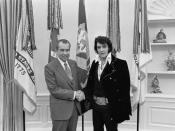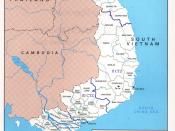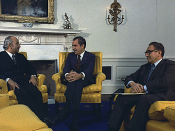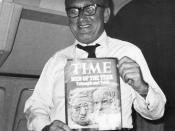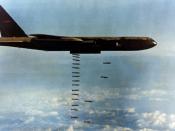OPERATION LINEBACKER II 1. What do you think of when you drive by that big B-52 at the museum? Being the history buff that I am, I think about Vietnam, where that old "Buff" was used the most. "Why should I care about Vietnam?" you ask yourself. Well, last time I checked there's a history section in the PFE guide, so there might be a test later! The intent of this paper is to inform you about Operation Linebacker II. I'll explain the events leading up to the operation, discuss the strategy, and finally I'll sum up the results of a bombing campaign Sir Michael Knight characterized In the book Strategic Offensive Air Operation as "...may have played a role not unlike two B-29s over Japan 27 years earlier". (Knight: 77) I'll start by explaining why President Richard Nixon gave the order to begin this new bombing campaign.
2. The primary goal of Linebacker II was to force North Vietnam to return to the Paris peace talks and sign a treaty agreement.
Negotiations stalled in December 1972 after Hanoi's chief negotiator, Le Duc Tho submitted unreasonable demands concerning the definition of the demilitarized zone and refused to withdraw troops from South Vietnam. Furthermore, he wouldn't accept the installation of an international peacekeeping force. National Security Advisor, Henry Kissinger, believed these demands were just a smokescreen intended to put off the talks long enough for the new United States Congress to come into session. He and Nixon feared, as written in Earl Tilford's book Setup-What the Air Force did in Vietnam and Why, that the Democratic controlled congress would "legislate the United States out of the war... and give Hanoi a better peace agreement by default". (Tilford: 253) Nixon wanted to wrap up the peace talks before that happened. How could the United States accomplish in two months what it hadn't in almost 12 years? 3. The tactics and aircraft used for Linebacker II were not new, but they were used differently than they'd ever been before. President Nixon pulled out all the stops, effectively untying the military's hands. He gave permission to bomb areas that had previously been off limits. Hanoi, Haiphong harbor, major military airfields, and other key objectives vital to the economy were now on the top of the hit list. On December 18, 1972 Operation Linebacker II began. Many different types of aircraft were used but the B-52 bomber played the biggest role. This was the first time the massive airplane was used over Hanoi. The Stratofortress was chosen because it could deliver 30 tons of bombs with pinpoint accuracy from high altitudes, at night, in any kind of weather, and for one other notable reason. According to Henry Kissinger the B-52 brought another aspect to the fight, a psychological impact brought on by it's sheer size and power. He was quoted in his book, Kissinger, as saying, "the B-52 had the ability to shock the mind and undermine the spirit". (Kissinger: 448) Hanoi however would prove to be no easy target. Colonel (Ret) A. L. Gropman is quoted in the book, War in the Third Dimension as saying, "no target in history was so well defended...not London, nor Ploesti, nor Berlin during the Second World War." (Mason: 56) High altitude, nighttime bombing had to be used to reduce the effectiveness of Hanoi's air defense triad. Anti-aircraft artillery couldn't shoot down the B-52s from 30,000 feet and Soviet built MIG fighters were suppressed with fighter escorts. The third spear of the triad, surface to air missiles, however, proved to be quite deadly. By 27 December Hanoi's air defenses were gone. Fighters and bombers were free to seek and destroy lucrative targets with relative impunity. After two more days of bombing North Vietnam finally admitted defeat. Linebacker II was over. It had taken its toll on both sides.
4. In Sir Michael Knights book Strategic Offensive Air Operations he wrote that in eleven days B-52s flew 729 sorties and dropped 15,000 tons of bombs. They destroyed 1500 buildings, 500 rail targets, 10 airfields, 25% of North Vietnamese fuel reserves, and 80% of their electrical generating capability. (Knight: 77) All of this destruction however came with a price; the U.S. lost 92 aircraft including 15 B-52s. (Air War...: 290) On 27 January 1973 the United States and the Republic of Vietnam, along with the Peoples Democratic Republic of Vietnam, signed an agreement ending the war. Two weeks later Vietnam released all prisoners of war; later that year American troops where withdrawn from South Vietnam.
5. In the course of this paper we've discussed why President Nixon ordered The Linebacker II campaign, North Vietnam's attempt to stall the peace talks. Next I explained the United States' strategy of employing the B-52 to bomb targets in and around Hanoi. Finally I covered the results of the operation. Vietnam returned to the bargaining table and signed the treaty ending the war. Everyone has heard the saying; "those who don't study history are destined to repeat it". I realize this is only one small piece of history, only 11 days out of an 11 year conflict, but it was Linebacker II that ended the Vietnam war and I for one don't want to see Vietnam repeated.
